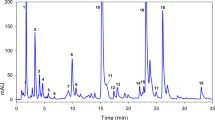Abstract
Leaves are, and will probably remain, an important dietary source of β carotene (provitamin A). There is enough of it in extracted leaf protein (LP) to make that a useful source. β carotene is rapidly destroyed when LP, especially from young leaves, is preserved with salt. Destruction can be partly prevented by avoiding contamination with iron during preparation, by coagulating LP by heating rather than acidification, and by treatment with chelating agents. The unsaturated fatty acids in leaf lipids seem not to be involved in the destruction.
Similar content being viewed by others
References
Arkcoll DB, Holden M (1973) Changes in chloroplast pigments during the preparation of leaf protein. J Sci Fd Agric 24:1217–1227
Bernstein L, Hamner KC, Parks RQ (1945) The influence of mineral nutrition, soil fertility, and climate on carotene and ascorbic acid content of turnip greens. Plant Physiol 20:540–572
Butler JB, Pirie NW (1981) An improved small scale unit for extracting leaf juice. Expl Agric 17:39–40
Cogdell RJ (1978) Carotenoids in photosynthesis. Phil Trans R S Lond 284:569–579
Cooke BC (1978) A study of the relationship between β carotene and fertility problems in dairy cows. Animal Production 26: 356–357
Davys MNG, Pirie NW (1969) A laboratory-scale pulper for leafy plant material. Biotech Bioeng 11:517–528
Food and Agriculture Organisation (1972) Food composition table for use in East Asia
Glazer AN (1983) Comparative biochemistry of photosynthetic light-harvesting systems. Annu Rev Biochem 52:125–157
Holden M (1978) A rapid and simple method for determining carotene in plant material. Xerophthalmia Club Bull 14:3
Hume EM (1921) Comparison of the growth-promoting properties for guinea-pigs of certain diets, consisting of natural foodstuffs. Biochem J 15:30–48
Kalac P, McDonald P (1981) A review of the changes in carotenes during ensiling of forages. J Sci Fd Agric 32:767–772
Kalač P, Kyzlink V (1980) The enzymic nature of the degradation of beta-carotene in red clover and in other forage crops during silage-making with acid additives. Animal Feed Sci Tech 5:59–68
Krinsky NI (1978) Non-photosynthetic functions of carotenoids. Phil Trans R S Lond 284:581–590
Peto R, Doll R, Buckley JD, Sporn MB (1981) Can dietary beta-carotene materially reduce human cancer rates? Nature 290:201–208
Pirie A (1983) Vitamin A deficiency and child blindness in the developing world. Proc Nutr Soc 42:53–64
Pirie NW (1978) Leaf protein and other aspects of fodder fractionation. Cambridge University Press, London UK
Pirie NW (1980) Temporary preservation of leaf protein. Ind J Nutr Dietet 17:349–352
Pirie NW (1982) The stability of β carotene in preserved, moist leaf protein. Proc Nutr Soc 41:142A
Pirie NW (1984) The stability of β carotene in moist, preserved leaf protein. In: Singh N (ed) Progress in Leaf Protein Research. Today & Tomorrow's Printers and Publishers, New Delhi, India 263–271
Roberts RH (1948) Blossoming and pigment content. Plant Physiol 23:379–387
Rothschild M, Valadon G, Mummery R (1977) Carotenoids of the pupae of the Large White butterfly (Pieris brassicae) and the Small White butterfly (Pieris rapae). J Zool 181:323–339
Sommer, A, Tarwotjo I, Hussaini G, Susanto D, Soegiharto T (1981) Incidence, prevalence, and scale of blinding malnutrition. Lancet 1407–1408
Tekale NS, Joshi RN (1977) Studies on the stability of carotenoid pigments in lucerne vegetation and juice. Ind Nutr Dietet 14:161–166
Thompson CR (1949) The carotene content of several varieties and strains of alfalfa. Agron J 41:294–297
Weinstein MC (1983) Cost-effective priorities for cancer prevention. Science 221:17–23
Author information
Authors and Affiliations
Rights and permissions
About this article
Cite this article
Pirie, N.W. Factors affecting β carotene destruction in moist preserved leaf protein. Plant Food Hum Nutr 34, 229–237 (1984). https://doi.org/10.1007/BF01091473
Received:
Revised:
Issue Date:
DOI: https://doi.org/10.1007/BF01091473



